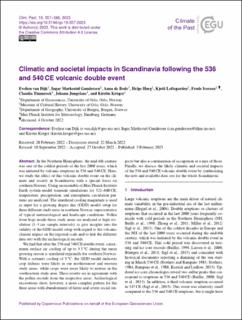| dc.description.abstract | In the Northern Hemisphere, the mid-6th century was one of the coldest periods of the last 2000 years, as indicated by both proxy records and Earth System Model (ESM) simulations. This cold period was initiated by volcanic eruptions in 536 CE and 540 CE. Evidence from historical sources, archaeological findings, and proxy records suggests that the extent and severity of this volcanic induced cooling was spatially heterogeneous and that the effect on society resulted in adaptation and resilience at some locations, whereas social crisis has been indicated at others. Here, we study the effect of the volcanic double event in 536 CE and 540 CE on the climate and society in Scandinavia with a special focus on Southern Norway. Using an ensemble of Max Planck Institute ESM transient simulations for 521–680 CE, the temperature, precipitation and atmospheric circulation patterns are studied. The simulated cooling magnitude is then used as input for the growing degree day (GDD) model set-up for Southern Norway. This GDD model indicates the possible effects on agriculture for three different study areas in Southern Norway, representative of typical meteorological and landscape conditions. Pollen from bogs and archaeological records inside the study area are then analysed at high resolution (1–3 cm sample intervals) to give insights into the validity of the GDD model set-up with regard to the volcanic climate impact on the regional scale, and to link the different types of data sets. After the 536/540 CE double event, a maximum surface air cooling of up to 3.5 °C during the mean growing season is simulated regionally in Southern Norway. With a worst-case scenario cooling of 3 °C, the GDD model indicates crop failures were likely in our northernmost and western study areas, while crops were more likely to mature in the southeastern study area. These results are in agreement with the pollen records from the respective areas. During the sixth century, excavations show an abandonment of farms, severe social impact but also a continuation of occupation or a mix of those. In addition, archaeological findings from one of the excavation sites suggest wetter conditions for the mid-sixth century in Scandinavia, as simulated by individual ensemble members. Finally, we discuss the likely climate and societal impacts of the 536/540 CE volcanic double event by synthesising the new and available data sets for the whole Scandinavia. | en_US |

